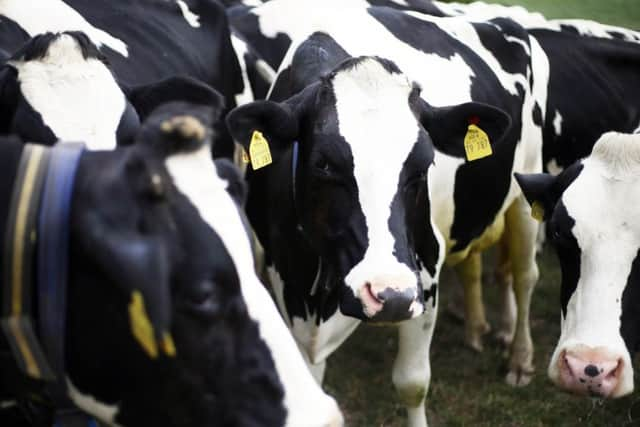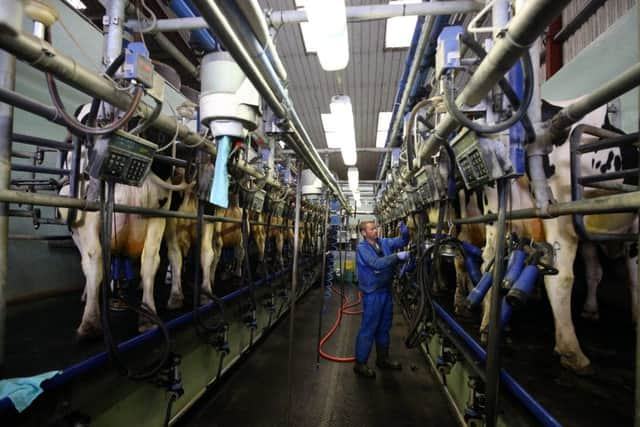Q&A: Milk price row explained


Protesters have been taking part in Milk Trolley Challenges, blockading distribution centres and even bringing cattle into supermarkets to raise awareness of their plight.
Milk prices have been falling steadily, with many farmers warning they are in a “desperate” situation.
• What are farmers paid for their milk?


Advertisement
Hide AdAdvertisement
Hide AdFarmers have seen the price they are paid per litre of milk (ppl) plummeting in recent years, with some losing up to 10p for each litre they sell. In January 2013, the average farm gate price paid for milk was 30.05ppl across the UK. Figures released by Defra for June 2015 put the average farmgate price paid at 23.66ppl.
This price is a 1.5% decrease or 0.37ppl less than the average price paid in May. The June 2015 price was 8.00ppl - or 25.3% - lower than in the same month last year.
Northern Ireland has seen the biggest falls in price paid to farmers, with the average price for June 2015 at 19.85ppl, a decrease of 1.03ppl or 4.9% compared with the previous month. The price is 9.88ppl or 33.2% lower than in June last year.
• What does it cost to produce milk?


ADHB Dairy, a not-for-profit organisation working for British dairy farmers, puts the cost “anecdotally” at between 30 to 32p to produce a litre of milk. Independently, many farmers say the cost of producing a litre of milk is at least 30 ppl.
• What is the effect on the dairy industry?
Advertisement
Hide AdAdvertisement
Hide AdThe number of dairy farmers in the UK was estimated to be at 25,000 in 2000. Producer numbers from the beginning of August 2015 show there are now 9,724 dairy farmers left in England and Wales - a fall of 53 from the previous month. When compared to the same month in the previous year, producer numbers have dropped by 421, or 4%, according to AHDB Dairy.
An average-size family dairy farm with 130 cows can expect to produce a million litres a year. Each penny taken off the price paid per litre causes an annual drop in income of about £10,000 for the farm. If the drop in price was 10p per litre - a cut seen by many farmers - that equates to a £100,000 loss in income.


• What is the bigger picture?
A review of the EU and global markets showed a continuation of imbalance between supply and demand, AHDB say.
Milk production in the 28 EU member states remains above 2014 levels, with stock described as excessive for cheese and milk powders.
Advertisement
Hide AdAdvertisement
Hide AdFarmgate prices are at an average of 34.08 euro/100kg, equivalent to 22.69ppl - their lowest point since June 2010 and further price cuts are expected.


• What is the Milk Trolley Challenge?
The Milk Trolley Challenge originated in Yate, south Gloucestershire, when a group of farmers were filmed lining up trolleys in a Morrisons supermarket before emptying the shelves of milk.
A woman is heard saying “Morrisons, you have been milked” in the footage, which was uploaded to YouTube.
Protesters have been paying for the milk and giving it away for free to customers outside supermarkets, donating money raised to charity. They have also been leaving trolleys full of milk at the checkout.
Advertisement
Hide AdAdvertisement
Hide AdThe original challenge took place on June 30 with more quickly following around the country, including Cornwall, Northern Ireland, Wales and Scotland.
• Why were two cows in a supermarket?
Protesters brought two heifers into Asda in Stafford on Sunday, with police called to the scene at 12.30pm. The cows were brought into the store to protest about the prices, with a campaigner saying: “This milk should not be cheaper than a bottle of water” in footage posted online.
A spokesman for Staffordshire Police said officers attended to ensure the protest “remained peaceful” and minimal disruption was caused to the public.
• What do consumers say?
A survey of 1,270 milk drinkers by market research organisation Mintel in June found 51% would be prepared to pay more than £1 for four pints of milk. The average price people were willing to pay was £1.28.
Currently, normal supermarket prices range from 89p to £1.